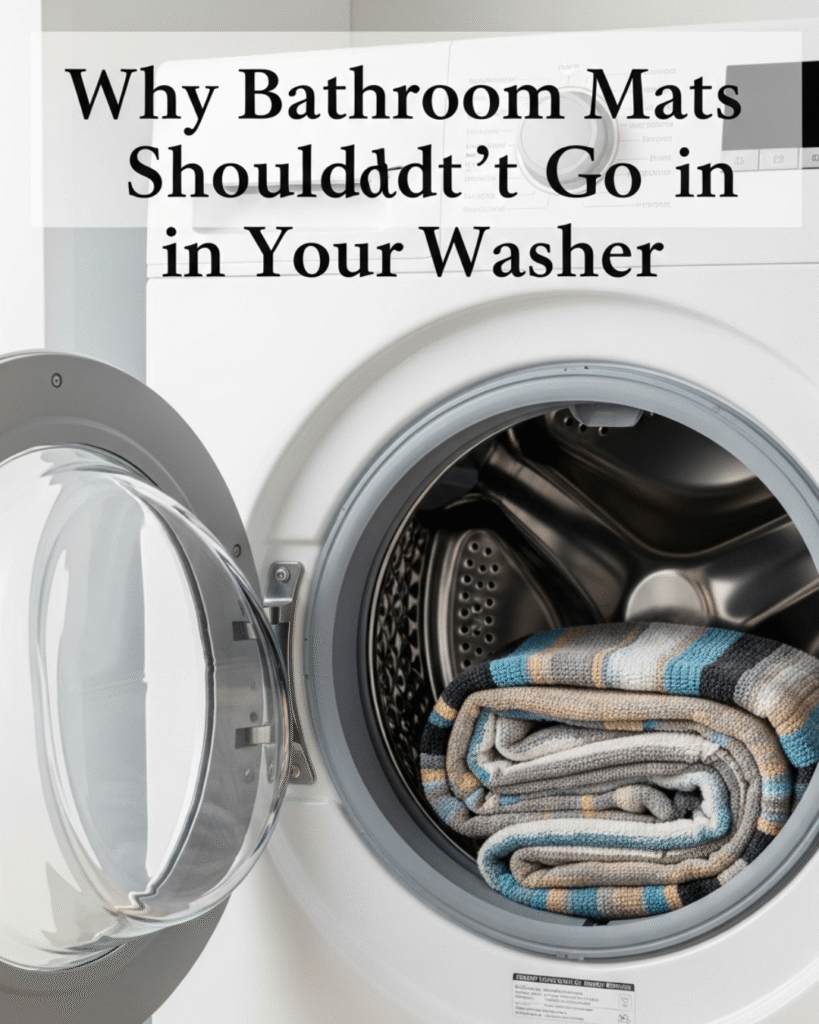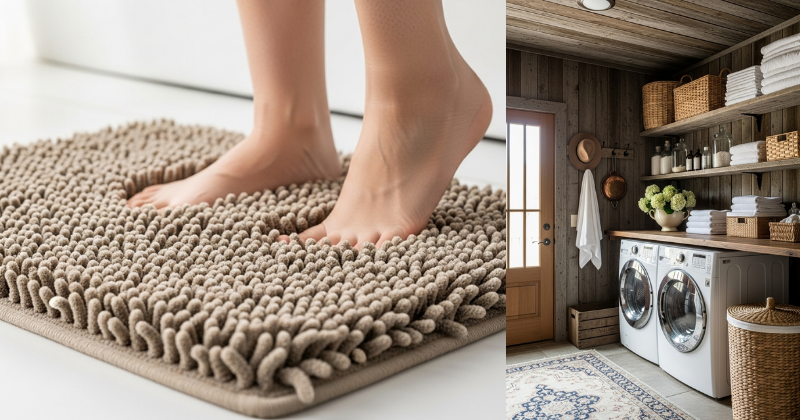The bathroom mat—that humble textile guardian standing sentinel between your bare feet and cold tile—harbors secrets that most homeowners never suspect. You’ve likely tossed yours into the washing machine countless times, assuming this modern convenience represents the pinnacle of hygiene and efficiency. Yet this seemingly innocuous habit may be orchestrating a slow mechanical deterioration that compromises both your appliance’s longevity and your mat’s functional integrity, while potentially introducing complications far more insidious than the dirt you’re attempting to eliminate.
Understanding why bathroom mats and washing machines represent an incompatible pairing requires us to journey into the hidden mechanics of textile construction, the engineering principles governing modern laundry appliances, and the chemical dynamics of rubber degradation. This knowledge transforms routine household maintenance into an informed practice that protects your investments while elevating your home care wisdom.

The Anatomy of Bathroom Mats: Understanding What You’re Actually Washing
Before we explore the complications inherent in machine washing, we must first appreciate the complex architecture of modern bathroom mats. These aren’t simple woven textiles but rather sophisticated composite structures designed to fulfill multiple contradictory demands simultaneously.
The Rubber Backing Dilemma
Most bathroom mats feature rubber or latex backing—a material chosen specifically for its non-slip properties that prevent dangerous bathroom falls. This backing typically consists of synthetic rubber compounds, often styrene-butadiene rubber or thermoplastic elastomers, engineered to maintain grip on wet surfaces while resisting moisture penetration.
The tragedy unfolds when this rubber encounters the aggressive mechanical action of washing machine drums. Rubber compounds, despite their apparent durability, possess a structural vulnerability to repeated flexing, twisting, and agitation. The violent tumbling motion of washing cycles—particularly spin cycles reaching 1,000 RPM or higher—subjects the rubber backing to mechanical stresses it was never designed to endure.
During each wash cycle, microscopic fractures propagate through the rubber matrix. These tiny fissures remain invisible initially but accumulate with each subsequent wash, eventually manifesting as visible cracking, flaking, or complete delamination. I’ve witnessed bathroom mats emerge from washers leaving behind a constellation of black rubber fragments—a forensic trail of material breakdown scattered across freshly laundered towels and clothing.
The Hidden Weight Problem
When dry, your bathroom mat seems innocuous enough. But saturated with water, it transforms into something altogether different—a heavy, waterlogged mass that can weigh three to five times its dry weight. Standard bathroom mats can absorb and retain several pounds of water within their fibers and backing.
This dramatic weight increase creates profound implications for your washing machine’s mechanical systems. Front-loading machines, in particular, suffer when attempting to spin such concentrated mass. The drum struggles to distribute weight evenly, leading to severe imbalance that triggers safety shutoffs or, worse, causes the machine to walk, vibrate excessively, or damage internal suspension components designed for more evenly distributed loads.
The Mechanical Havoc: What Happens Inside Your Washing Machine
The relationship between bathroom mats and washing machine mechanisms represents a fascinating case study in engineering incompatibility—two systems designed without consideration for their eventual interaction.
Drainage System Catastrophe
As rubber backing deteriorates during the wash cycle, it doesn’t simply vanish. Those fragments—ranging from microscopic particles to substantial chunks—must travel somewhere. They enter your machine’s drainage system, a network of hoses, pumps, and filters engineered for lint, hair, and fabric fibers, not resilient rubber compounds.
Rubber particles possess properties fundamentally different from typical laundry debris. They don’t dissolve, they resist water flow, and their tacky surface adheres to pump components and filter screens. Over time, these accumulations create blockages that reduce drainage efficiency, force pumps to work harder, and eventually lead to complete system failure requiring costly professional repair.
I once consulted with an appliance repair technician who shared that rubber-based drain clogs represent one of the most challenging service calls—often requiring pump replacement rather than simple cleaning because the rubber bonds so tenaciously to metal and plastic components.
The Balance and Bearing Crisis
Modern washing machines employ sophisticated balancing systems with sensors that detect load distribution and adjust spin speeds accordingly. When a heavy, irregular object like a saturated bathroom mat occupies the drum, these systems face an impossible task.
The concentrated weight creates eccentric loading—imagine trying to spin a wheel with a heavy weight attached to one side. The machine attempts to compensate by reducing spin speed or redistributing the load, but bathroom mats resist redistribution due to their size and water retention. This mechanical struggle places extraordinary stress on drum bearings, suspension springs, and shock absorbers—components designed for decades of service under normal conditions but vulnerable to premature failure under repeated extreme loading.
The Superior Alternative: Hand Washing and Proper Maintenance Techniques
Abandoning machine washing doesn’t mean accepting permanently soiled bathroom mats. Rather, it invites you to embrace more intentional, effective cleaning methods that honor both the mat’s construction and your home’s mechanical systems.
The Bathtub Washing Ritual
Your bathtub represents the ideal bathroom mat cleaning vessel—spacious, waterproof, and perfectly suited for manual agitation without mechanical stress. Fill your tub with warm water and add a gentle detergent, preferably one formulated for delicate fabrics or rubber-backed items.
Submerge your mat completely, using your feet to gently agitate and work the soapy water through the fibers. This method might seem quaintly old-fashioned, but it offers superior control over cleaning intensity while completely eliminating mechanical stress on the rubber backing. The tactile engagement transforms a mundane chore into a mindful practice—you can feel the dirt releasing, observe the water’s changing opacity, and make real-time decisions about when the mat has achieved true cleanliness.
After thorough agitation, drain the soapy water and refill with clean water for rinsing. Repeat this process until the rinse water runs clear, then gently press—never wring or twist—excess water from the mat before hanging it to dry.
The Outdoor Cleaning Method
For those blessed with outdoor space, consider the garden hose method—a technique that combines efficiency with gentleness. Drape your mat over a sturdy railing, fence, or outdoor table. Apply liquid detergent directly to soiled areas, then use a soft-bristled brush to work the cleaner into the fibers.
Rinse thoroughly with a garden hose, allowing the natural pressure and volume of water to flush away dirt without the violent mechanical action of washing machines. The outdoor setting provides abundant ventilation for drying, and the sun’s natural antibacterial properties offer an additional hygiene benefit that indoor drying cannot match.
Extending Mat Lifespan: Strategic Maintenance Between Deep Cleans
True bathroom mat care extends beyond periodic washing to encompass daily and weekly maintenance practices that prevent soil accumulation and extend functional lifespan.
The Daily Shake-Out Ritual
Each morning, after your shower, take thirty seconds to shake your bathroom mat vigorously outside or over a bathtub. This simple practice dislodges loose hair, dust, and surface moisture before they can embed into fibers or create conditions favorable for bacterial growth.
This ritual costs nothing, requires minimal time, yet dramatically reduces the frequency of deep cleaning required. I’ve found that mats receiving daily shake-outs remain fresher for three to four times longer than neglected counterparts.
The Weekly Vinegar Refresh
Between deep cleans, maintain your mat’s freshness with a weekly vinegar spray treatment. Mix equal parts white vinegar and water in a spray bottle, lightly mist your mat’s surface, and allow it to air dry completely. Vinegar’s natural acidity neutralizes odors, inhibits mildew growth, and breaks down soap residue without requiring water saturation or mechanical washing.
This intermediate maintenance step keeps your mat hygienically sound while spacing out the intervals between labor-intensive deep cleans.
When Replacement Becomes Wisdom: Recognizing Mat Mortality
Even with impeccable care, bathroom mats possess finite lifespans determined by material degradation, structural fatigue, and hygiene considerations that transcend visible appearance.
The Signs of Graceful Retirement
Observe your mat for telltale indicators that its service has reached natural conclusion. Rubber backing showing widespread cracking, even without active flaking, has lost its structural integrity and slip-resistance properties. Persistent odors that resist cleaning treatments suggest bacterial colonization deep within the mat’s structure—a condition that proper hygiene cannot remedy.
Visible thinning of the textile pile, especially in high-traffic areas near the shower or tub, indicates that the mat’s absorbency and cushioning functions have diminished beyond effective restoration. When these signs emerge, replacement represents not wastefulness but rather prudent hygiene and safety practice.
Sustainable Disposal and Replacement Strategies
When retiring bathroom mats, consider repurposing options before relegating them to landfills. Mats with compromised backing but intact textile surfaces can serve as garage workshop kneeling pads, gardening cushions, or protective layers for delicate items during storage or transport.
When selecting replacement mats, prioritize quality over economy. Well-constructed mats with reinforced rubber backing and dense, tightly woven pile resist degradation and maintain functionality far longer than cheaper alternatives, ultimately representing superior value despite higher initial cost.
The Broader Philosophy: Respecting Material Limitations
This exploration of bathroom mat care illuminates a principle with applications extending far beyond laundry—the importance of understanding material properties and respecting the limitations inherent in object design.
Modern convenience culture encourages us to treat washing machines as universal cleaning solutions, capable of accommodating any washable item. Yet this assumption ignores the nuanced engineering compromises inherent in both textile construction and appliance design. Not every washable item benefits from machine washing, and recognizing these distinctions represents sophisticated home management rather than inconvenient limitation.
Your bathroom mat serves faithfully, day after day, preventing slips, absorbing moisture, and contributing to your home’s comfort and safety. Honoring its construction through appropriate cleaning methods extends its service life, protects your washing machine, and elevates your relationship with the objects that sustain your daily rituals.
The path forward requires neither expensive equipment nor complicated techniques—simply awareness, intention, and willingness to invest brief moments of manual care. Your bathroom mat, your washing machine, and your household budget will thank you for this wisdom, returning your consideration with extended service and reliable performance.
Embrace these alternative cleaning methods not as regression to pre-mechanical drudgery but as evolution toward more conscious, sustainable home maintenance that honors both material properties and mechanical systems. The satisfaction you’ll discover in this mindful approach transcends mere cleanliness, touching something deeper—the quiet fulfillment of caring well for the objects that care for you.
